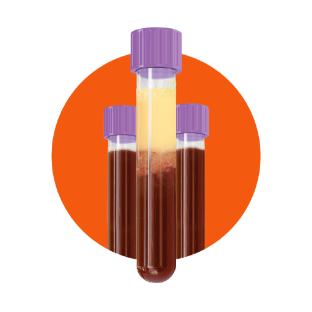Diagnostic of severe hypertriglyceridemia is based on a three-step approach:
- Focus: monogenetic severe HTG, familial chylomicronemia syndrome (FCS)

High triglyceride evaluation
FCS: Milky blood sample or triglyceride level >885mg/dl (>10 mmol/L)1
Identify candidates for genetic testing
FCS score ≥72
Genetic test of possible affected genes
FCS: LMF1, ApoA5, ApoC2, GPIHBP1, CREB3L3, GPD1, GCKR3,4
1 High triglyceride evaluation
High triglyceride levels can be caused by genetic factors or present as a result of other conditions or certain medications.3,5
The extent of elevation offers important clues about the cause.
FCS: Extremely high triglyceride levels (>10 mmol/L; 885mg/dl) or lipaemic blood (ie, fatty blood with milk-like appearance) require further assessment5, even in absence of typical FCS symptoms, such as abdominal pain.

FCS Diagnostic Algorithm
Identify FCS patients by using this Diagnostic Algorithm.
Take the test by clicking your way through each question.
Does your patient have hypertriglyceridemia?
TG 200-885mg/dl
(2-9,9 mmol/l
TG >885mg/dl
(>10 mmol/l)
Think of:
Primary Genetic1
> Familial Combined Hyperlipidemia
> Familial Hypertriglyceridemia
> Dysbetalipoproteinemia
Secondary
Alcohol, Obesity, T2DM,
Hypothyroidism, Oestrogen,
Corticosteroids
FCS score
Test for these genes
LPL, APO A5, APO C2, APO C3, APO E, CREB3L3, GCKR, GPD-1, GPIHBP1, LMF-1
Genetic testing: report
LPL, APO A5, APO C2, CREB3L3, GCKR, GPD-1, GPIHBP1, LMF-1
Pathogenicity: pathogenic or probably pathogenic variant (influence of the mutation is large enough to cause the disease on its own), variant of unclear significance.
- Homozygous, recessive variants
- Mixed heterozygous variants
- Heterozygous co-dominant variants
LPL, APO A5, APO C2, APO C3, APO E, CREB3L3, GCKR, GPD-1, GPIHBP1, LMF-1
Pathogenicity: risk factor, disease-associated or variant of unclear significance
Heterozygous variants with large metabolic effects + SNPs.
Combination of common SNPs* / genetic polymorphisms with small effects in approx. 40 genes.
Sporadic severe HTG: one or NO marginally functional
Possible diagnosis
Monogenetic* HTG, also known as familial chylomicronemia syndrome: The genetic load is high enough to cause constant HTG, regardless of other factors such as additional mutations or lifestyle factors.
Please note:
Each patient must be assessed individually, in particular the pathogenicity of the respective genetic variant. The final diagnosis must be made in collaboration with the geneticist and in consideration of the clinic.
*Monogenetic: The genetic load is high enough to cause a constant HTG, regardless of other factors such as additional mutations or lifestyle factors.
Possible diagnosis
Polygenetic HTG, also known as multifactorial chylomicronemia syndrome: A single mutation is not sufficient to cause a clinical phenotype. The severity of HTG is determined by cumulative/interactive effects of several genetic risk variants.*
Please note:
Each patient must be assessed individually, in particular the pathogenicity of the respective genetic variant. The final diagnosis must be made in collaboration with the geneticist and in consideration of the clinic.
*These risk variants include both heterozygous rare variants with major metabolic effects and frequent variants (polymorphisms) with minor effects. These mutations occur in combination with TG-increasing SNPs. A large number of SNPs with an effect on TG can also lead to polygenic HTG on its own.
Does your patient have Hypertriglyceridemia?
Moderately high triglyceride levels (2-9,9 mmol/L; 200-885 mg/dl) suggest:6
Secondary hypertriglyceridemia, associated with:
- Obesity
- Type 2 diabetes
- Kidney disease
- Hypothyroidism
- Certain medications (e.g., thiazides, beta blockers, oestrogen, corticosteroids)
Primary (genetic) hypertriglyceridemia, associated with:
- Familial combined hyperlipidemia
- Familial hypertriglyceridemia
- Dysbetalipoproteinemia
Individuals with moderately high triglyceride levels should be further evaluated for potentially increased risks of cardiovascular disease.6
Severely high triglyceride levels (>10 mmol/L; >885mg/dl) suggest:
A genetic defect, especially if the blood sample has been:5
- Lipaemic (with milky appearance) on several occasions
- The patient has reported abdominal pain (especially with signs such as tuberous xhantoma or lipemia retinalis)
- The patient has a history of recurrent pancreatitis.
The execution of the FCS score5 might help to select patients for genetic test confirmation. Severe hypertriglyceridemia requires further evaluation because the patient might be a risk for acute pancreatitis.
Likely causes of severely high triglyceride levels are:
Polygenic Hypertriglyceridemia3
A single mutation is not sufficient to cause a clinical phenotype. The severity of HTG is is determined by cumulative/interactive effects of several genetic risk variants.*
- Genetic propensity (>300 single nucleotid variants identified)
- Major contribution of secondary factors (e.g., obesity or type 2 diabetes)
- Estimated prevalence: 600
Monogenic hypertriglyceridemia3
The genetic load is high enough to cause a constant HTG, regardless of other factors such as additional mutations or lifestyle factors.
- Genetic etiology (see Causes and Pathophysiology)
- Minor contribution of secondary factors
- Estimated prevalence: 100.000 - 1.000.000
*These risk variants include both heterozygous rare variants with major metabolic effects and frequent variants (polymorphisms) with minor effects. These mutations occur in combination with TG-increasing SNPs. A large number of SNPs with an effect on TG can also lead to polygenic HTG on its own.
Adapted from Moulin 2018
2 Identify candidates for genetic testing
In clinical practice there are several conditions characterized by high levels of triglycerides, some essentially genetic and some secondary to other diseases or medications.6
The FCS score
Due to their increased risk of acute pancreatitis, patients with severely high triglyceride levels should be evaluated further. The FCS score test may help identify candidates for FCS genetic testing.5
Click the Yes/No buttons in the score-tool below in order to start the test
(FCS diagnosing score adapted from Moulin 2018).
A printable version can be downloaded here
3 Genetic testing
Genetic testing is suggested for individuals with the FCS score of 7 or higher.2 The list of specialized laboratories by country that perform FCS testing can be found at OrphaNet.
Additional diagnostic considerations: Phenotypic differentiation of FCS and MCS
In addition to the FCS score, the following phenotypic differentiation can help estimate whether a patient with severely high triglyceride levels has monogentic HTG, FCS, or polygentic HTG, MCS.
Phenotypic differentiation of FCS and MCS7
| Features | FCS | MCS |
|---|---|---|
| Age of onset | Childhood or early adolescence | Adulthood |
| Body mass index | Normal | Overweight or obese |
| Recurrent acute pancreatitis | Common | Less common |
| Hospital admissions | Common | Less common |
| Lipoprotein pathology | Increased number of chylomicron particles Low LDL Low HDL |
Increased number of chylomicron remnant particles High VLDL High ILDL |
| Atherosclerotic cardiovascular disease | Less common | Common |
| Metabolic syndrome | Less common | Common |
| Post-heparin LPL activity | Very low | Normal or slightly reduced |
| Response to traditional lipid-lowering treatment | Absent | Moderate or poor |
| Former designations | Familial chylomicronemia, hyperlipoproteinemia type 1 (WHO) | Mixed dyslipidemia, hyperlipoproteinemia type 5 (WHO) |
| Main lipoprotein disorder | Variable increase in TG-rich lipoproteins: Chylomicrons, VLDL, chylomicron remnants and VLDL remnants | |
| Ass. Lipoprotein disorders | Reduction of LDL and HDL | |
| Typical start | Childhood or adolescence | Adulthood |
| Clinical features |
|
|
| Cardiovascular risk | Only slightly increased | Some indications of increased risk |
| Prevalence rate | Rare, ~1:100,000 to ~1:1,000,000 | Frequent, ~1:600 |
| Influence of non-genetic factors on the phenotype | Low | High |
| Inheritance pattern | Autosomal recessive, occasionally autosomal co-dominant | Familial clustering, but no classic Mendelian inheritance |
| Genetic causes |
|
|
| Therapy goal |
|
|
Table modified and supplemented according to Brahm (2015)
* SNPs = single nucleotide polymorphism = susceptibility variants = polymorphisms
Additional diagnostic considerations: Diagnosis of acute pancreatitis8
Two of the following:

| 1Lipase | 3 x upper limit of normal | |
| 2Abdominal pain | Consistent with pancreatitis |
|
| 3Abdominal imaging | Findings of pancreatitis Imaging does not need to be performed in every patient with pancreatitis |
|
References
- Baass A, et al. Familial chylomicronemia syndrome: an under-recognized cause of severe hypertriglyceridaemia (Review). J Intern Med 2020; 287: 340–348.
- Bashir et al. Atherosclerosis 391 (2024) 117476¸ https://doi.org/10.1016/j.atherosclerosis.2024.117476
- Bashir B, et al. Severe Hypertriglyceridaemia and Chylomicronaemia Syndrome— Causes, Clinical Presentation, and Therapeutic Options. Metabolites. 2023; 13(5):621.
- Hegele RA, et al. Rare dyslipidaemias, from phenotype to genotype to management: a European Atherosclerosis Society task force consensus statement Lancet Diabetes Endocrinol 2020; 8: 50–67.
- Moulin P, et al. Identification and diagnosis of patients with familial chylomicronaemia syndrome (FCS): Expert panel recommendations and proposal of an ”FCS score”. Atherosclerosis. 2018;275:265–272.
- Laufs U, et al. Clinical review on triglycerides. European Heart Journal (2020) 41, 99–109.
- Brahm AJ, Hegele RA, Chylomicronemia and current diagnosis and future therapies, Nat. Rev. Endocrinol. 11 (6) (2015) 352e362.
- Pancreatitis Pain: Causes, Symptoms, Diagnosis, Treatment. Available at: www.ezmedlearning.com/blog/pancreatitis-causes-symptoms-diagnosis-treatment.
Management
FCS management includes dietary control, pharmacological treatment, and treatment of acute pancreatitis.
Symptoms and complications
Learn more about the broad spectrum of signs and symptoms that are associated with FCS.
Causes and Pathophysiology
FCS is a monogenic disease with different pattern of inheritance. In 80-90% of patients with FCS, low activity of lipoprotein lipase (LPL) is caused by mutations in the gene that encodes this enzyme.

